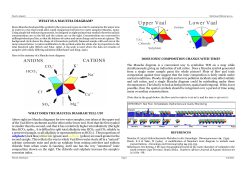
How to name ionic compounds with polyatomic ions
How to name ionic compounds with polyatomic ions SNC2D1 NaCl (table salt) enhances flavour and extends shelf life Sodium phosphate is a white solid, relatively stable, and an electrolyte Chemical formula: Na3PO4. Sodium, Na = cation Phosphate, (PO4)3- = anion This is an example of a POLYATOMIC ION Polyatomic Ions “poly” means “many” consists of a stable group of several atoms acting together as a single charged particle The ionic charge of a polyatomic ion is shared over the entire ion rather than being on just one atom The phosphate ion is made up of 4 oxygen atoms bonded to a central phosphorus atom = (PO4)3- Naming Compounds with Polyatomic Ions Example 1: Write the name of the compound Na2CO3 Step 1: Write the name of the metal and check whether is has more than one ionic charge Sodium (always has a charge of +1) Step 2: Recognize and name the polyatomic ion CO3 is the carbonate ion Step 3: Write the name of the compound The name of Na2CO3 is Sodium carbonate Example 2: What is the name of Ca(OH)2? Step 1: Calcium (always has a charge of +2) Step 2: (OH) is the hydroxide ion Step 3: The name of Ca(OH)2 is Calcium hydroxide Example 3: What is the name of Fe(NO3)3? Step 1: Iron (has a charge of +2 or +3) Step 2: Determine the ionic charge of iron! Fex + 3(NO3)1- = 0 x + 3(-1) = 0 x + (-3) = 0 x = +3 Therefore, the charge on the Fe ion is +3 Step 3: (NO3) is the nitrate ion Step 4: The name of Fe(NO3)3 is Iron (III) nitrate Writing chemical formulas involving polyatomic ions Example 1: Write the formula for sodium phosphate Step 1: Write the symbols and ionic charges above each symbol Step 2: Determine how many of each ions are required to give a total charge of zero OR use the criss-cross method Step 3: Write the chemical formula using subscripts Method #1 Na1+ + (PO4)3___(+1) + ___(-3) = 0 3 (+1) + 1 (-3) = 0 (+3) + (-3) = 0 Chemical formula: Na3(PO4) Criss-Cross Method (Na)1+ (PO4)3Na3 (PO4)1 Chemical formula: Na3(PO4) Example 2: What is the chemical formula for copper (II) nitrate? Method #1 Criss-Cross Method Cu2+ + (NO3)1___(+2) + ___(-1) = 0 1 (+2) + 2 (-1) = 0 (+2) + (-2) = 0 Chemical formula: Cu(NO3)2 (Cu)2+ (NO3)1Cu1 (NO3)2 Chemical formula: Cu(NO3)2 Example 3: What is the chemical formula for ammonium carbonate? Method #1 Criss-Cross Method (NH4)1+ + (CO3)2___(+1) + ___(-2) = 0 2 (+1) + 1 (-2) = 0 (+2) + (-2) = 0 Chemical formula: (NH4)2(CO3) (NH4)1+ (CO3)2- (NH4)2 (CO3)1 Chemical formula: (NH4)2(CO3) Oxyacids A special group of polyatomic ions Formed when hydrogen combines with polyatomic ions that contain oxygen In these compounds, hydrogen has an ionic charge of +1 See Table 3 on page 198 for examples of common oxyacids
© Copyright 2025





















